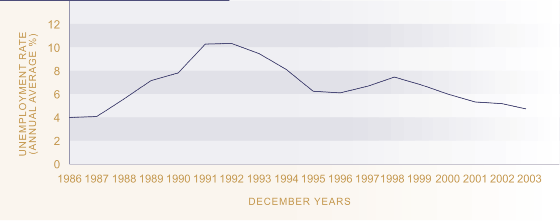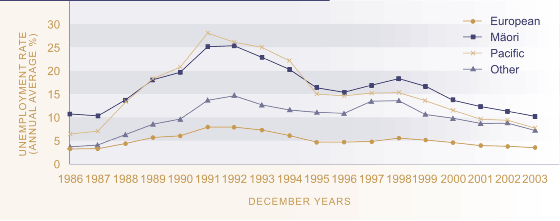Relevance
This is a key indicator of labour market outcomes and lack of access to employment. The unemployment rate is an important reflection of overall economic conditions and of the ease with which people are able to move into employment.
Current Level and Trends
In 2003, 4.7 percent of the labour force, or 93,900 people, were unemployed and actively seeking work. The unemployment rate has steadily declined since 1998 and is considerably lower than the peak rate of 10.3 percent in 1991/1992 (almost 170,000 people unemployed), but is still a little higher than the rate of 4.0 percent in 1986 (64,000 people unemployed).
In 2003, 27 percent of the surveyed unemployed were unemployed for a continuous period of six months or more, compared with 29 percent in 2002. This was still higher in 2003 than it had been in 1986, when it was 22 percent, but was substantially lower than the peak of 53 percent in 1992/1993.
Figure PW1.1 Unemployment rate, 1986-2003

Source: Statistics New Zealand,
Household Labour Force Survey
The economy's improved performance over the last decade has contributed to the steady decline in the unemployment rate over this time. Changes in the regulation of the labour market and the benefit system may also have had some effect.43
Ethnic Differences
Substantial differences in unemployment rates persist for different ethnic groups. Māori unemployment rose from 10.7 percent in 1986 to a peak of 25.4 percent in 1992 but fell back to 10.2 percent by 2003, the best rate recorded since the survey began. Between 1986 and 1991, the unemployment rate for Pacific peoples rose from 6.5 percent to 28.0 percent, the highest rate for any ethnic group. Pacific peoples' unemployment rate has declined more than that of Māori since the mid-1990s, and was 7.7 percent in 2003. Pacific unemployment is still higher than it was in 1986.
Unemployment is lowest among people of European ethnicity; their unemployment rate rose from 3.2 percent in 1986 to a peak of 7.9 percent in 1992 and had declined to 3.5 percent by 2003. The unemployment rate among the 'Other' ethnic group category (which comprises predominantly people of Asian ethnicity and includes many recent migrants) increased from 3.6 percent in 1986 to 14.7 percent in 1992, and was still relatively high at 7.2 percent in 2003.
Figure PW1.2 Unemployment rate by ethnic
group, 1986-2003

Source: Statistics New Zealand, Household Labour Force
Survey
Age and Sex Differences
Unemployment rates among different age groups have followed similar trends but the level among those aged 15-24 (10.2 percent in 2003) has been consistently more than twice the rate for older groups. This group comprised 39 percent of all unemployed in 2003. Unemployment rates have been fairly similar for males and females since the mid-1990s. However in 2003, the female unemployment rate was marginally higher than the male unemployment rate.
Table PW1.1: Unemployment rates (%), by age and sex, selected years, 1986-2003
| Year | 15-24 | 25-44 | 45-64 | Total 15+ | Males | Females |
|---|---|---|---|---|---|---|
| 1986 | 7.9 | 3.1 | 1.7 | 4.0 | 3.5 | 4.6 |
| 1991 | 18.8 | 8.8 | 5.8 | 10.3 | 10.9 | 9.5 |
| 1996 | 11.8 | 5.2 | 4.0 | 6.1 | 6.1 | 6.1 |
| 2001 | 11.8 | 4.4 | 3.3 | 5.3 | 5.4 | 5.3 |
| 2002 | 11.4 | 4.4 | 3.1 | 5.2 | 5.1 | 5.3 |
| 2003 | 10.2 | 4.1 | 2.8 | 4.7 | 4.4 | 5.0 |
Source: Statistics New Zealand, Household Labour Force Survey
Regional Differences
In 2003, regional unemployment rates were highest in Northland (8.0 percent) and Bay of Plenty (6.3 percent), and lowest in Southland and Tasman-Nelson-Marlborough-West Coast (each 3.5 percent). The fall in unemployment between 1992 and 2003 was greatest in the Auckland region.
International Comparison
In 2003, New Zealand ranked eighth best out of 27 OECD countries with a standardised unemployment rate of 4.7 percent, compared with an OECD median of 6.0 percent. Since the mid-1980s, New Zealand's unemployment rate relative to other OECD countries has ranged from one of the best (ranked fifth in 1986 with a rate of 4.0 percent) to one of the worst (ranked 17th in 1992 with a rate of 10.3 percent) to a more favourable position in recent years. South Korea had the best unemployment rate in 2003 (3.6 percent). The New Zealand unemployment rate in 2003 was lower than that of Australia (6.1 percent), Canada (7.6 percent), the United Kingdom (5.0 percent) and the United States (6.0 percent).44 In 2002, New Zealand ranked seventh best in terms of the proportion of the unemployed who had been unemployed for six months or longer.45
